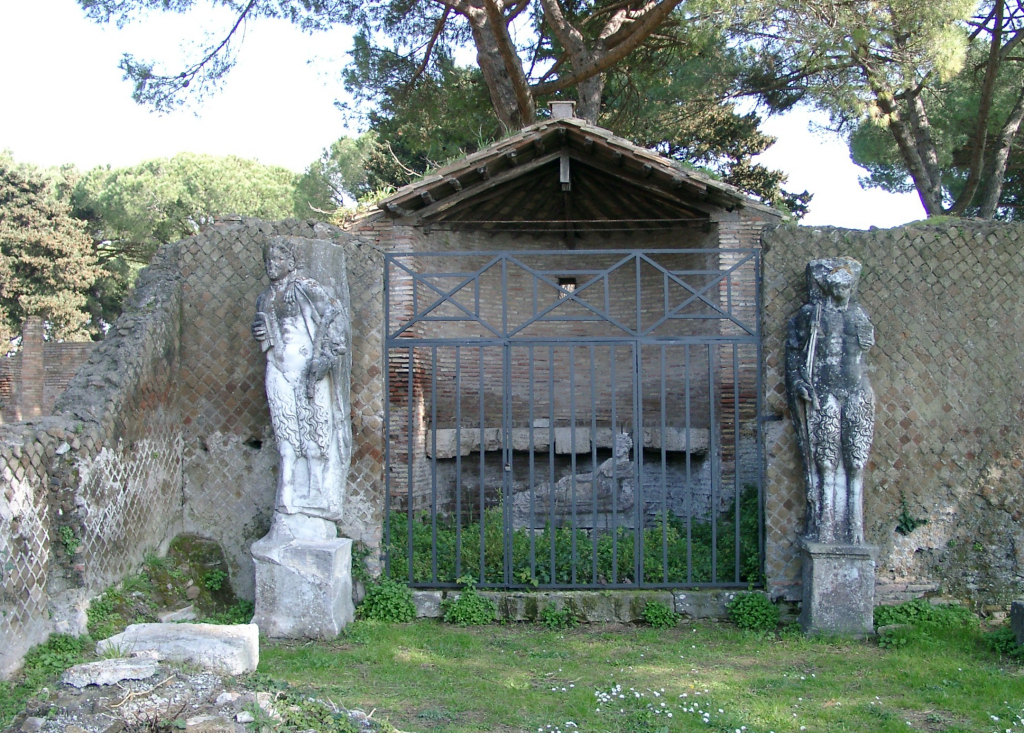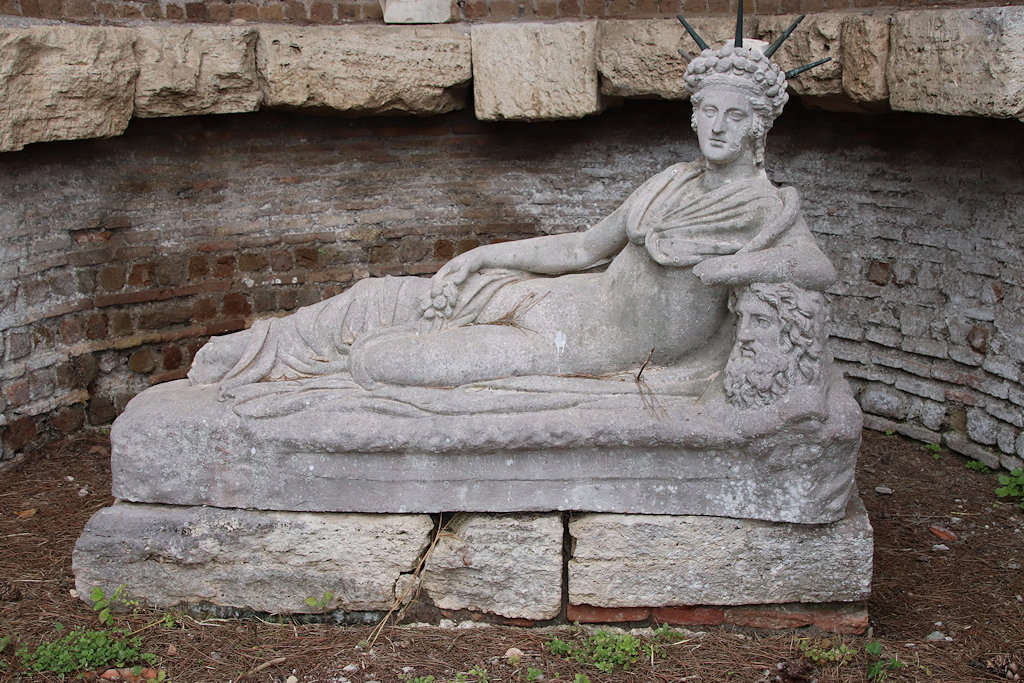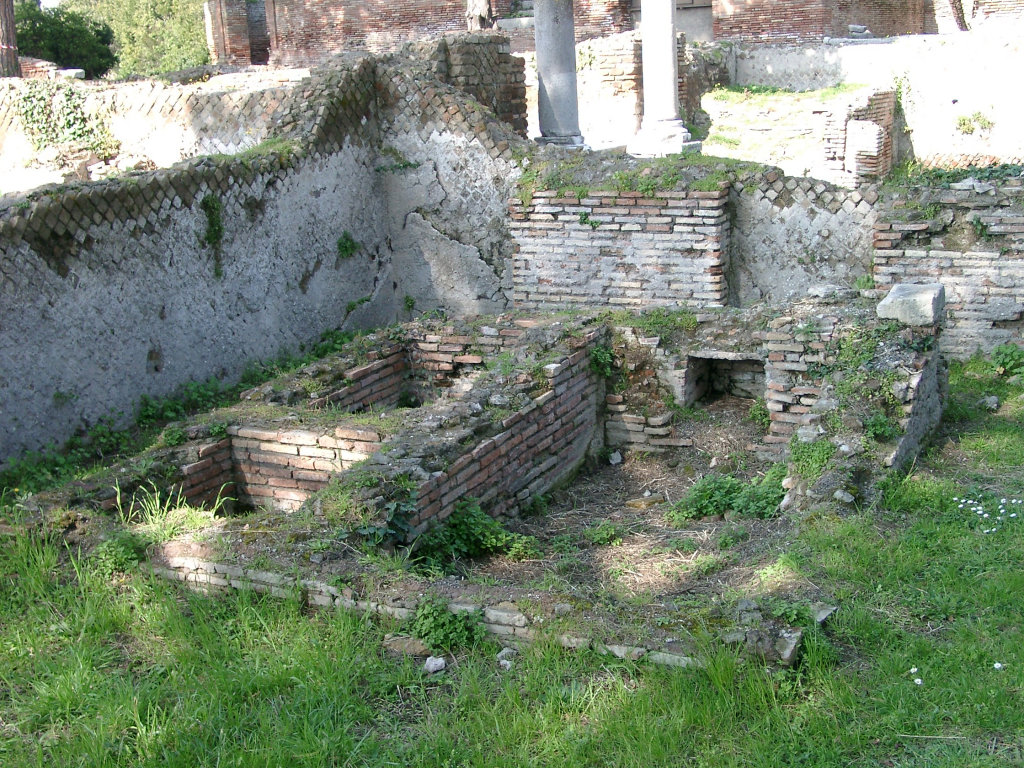The Sanctuary of Attis or Attideum is situated on the east side of the Field of the Magna Mater. It is preceded by a fairly large area (c. 9.90 x 11.10) without a roof, surrounded by a wall (opus reticulatum from the Julio-Claudian period). The open area was entered from the west. The entrance is decorated by a porch with two marble pilasters, and has three steps on the outside and two on the inside. On the floor is opus spicatum. In this open area are three basins. It has been suggested that these were fish-ponds, because there are a few references of fish being offered to Attis.
Plan of the east part of the temple-complex of the Magna Mater.
From Vermaseren 1977, fig. 24.The actual shrine (3) was added in the third quarter of the third century at the south-east side (opus latericium and vittatum). The entrance is flanked by two semi-columns with large, marble reliefs of Pan, each with a six-reeded shepherd's pipe and a shepherd's crook. The reliefs have been dated to the second half of the third century. It seems that they were damaged on purpose, presumably by Christians. The back wall contains an apse, in the side walls are two shallow rectangular niches. In the centre of the apse, at a height of c. 3.00, is a small rectangular window. In the lower part is a semicircular travertine ledge, presumably for votive offerings.
In the apse is a plaster cast (the original is in the Vatican Museums) of a statue of a reclining Attis, after the emasculation. In his left hand is a shepherd's crook, in his right hand a pomegranate. His head is crowned with bronze rays of the sun and on his Phrygian cap is a crescent moon. This suggests astrological aspects: Attis was regarded as a solar deity and identified with the moon-god Men. He is leaning on a bust, probably the personification of the river Gallos, where he had died. His posture is reminiscent of river gods (the river Gallos), but the statue also brings to mind sarcophagi, with a depiction of the deceased on the lid. The statue is a dedication by Caius Cartilius Euplus, witness the inscription on the plinth:
NVMINI ATTIS C(aius) CARTILIVS EVPLVS
EX MONITV DEAETo the divine majesty of Attis, Caius Cartilius Euplus,
after an admonition by the goddess.It was found in 1867 in the porticus along the south side, together with a bronze statue of Venus, and a statue of a cock dedicated by Marcus Modius Maximus. The objects seem to have been hidden there in late antiquity. Originally they may well have been standing in this shrine. The cock (gallus, referring to the priests, galli) is standing on a round object with grain-ears on top. It may be a depiction of a modius, a grain-measure, referring to the name of the giver, and perhaps to his profession.
Many small statues and reliefs were found in or near the shrine by Guido Calza, now to be seen in the Ostian museum. Many of these were given by Caius Cartilius Euplus.
- Statuettes and reliefs of Attis: riding a lion, playing the shepherd's pipe seated on a rock amidst his herd, dying under a pine-tree after his emasculation, Attis - Dionysus, Attis - Apollo, Attis - Hermaphrodite.
- A round altar with twelve gods: Jupiter, Juno, Minerva, Magna Mater / Cybele or Ceres, Venus, Diana, Vesta, Apollo, Vulcanus, Mercurius, Neptunus and Mars.
- Several statuettes of Venus.
- Fortuna or Ceres.
- A warrior with a helmet, carrying a small round shield.
- A relief of a lion attacking a deer, a panther and some bears, all animals of the forest, of which the goddess is the mistress.
- A bull.
- A pine-tree with a snake.Caius Cartilius Euplus lived in the second century AD. His dedications were eventuallly placed in the third-century apse. We do not know where they stood originally.
The statue of Attis-Dionysus is of great interest for the situation in late antiquity. It is a dedication by a Volusianus, vir clarissimus. This may be Caius Ceionius Rufus Volusianus Lampadius, Praefectus Urbi in 365-366 AD. This man and other members of his family also put up dedications in the Phrygianum in Rome, a large sanctuary of the Magna Mater in campo vaticano, next to the old St. Peter. This family is regarded as a typical example of upper class supporters of pagan religion in late antiquity.


